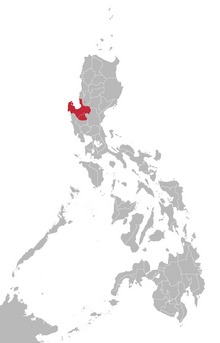Pangasinan language facts for kids
Quick facts for kids Pangasinan |
||||
|---|---|---|---|---|
| Pangasinense Salitan Pangasinan |
||||
| Native to | Philippines (Ilocos Region & Central Luzon) | |||
| Region | Pangasinan, northern Tarlac, southern La Union, southwestern Benguet, northwestern Nueva Ecija, northern Zambales, and southwestern Nueva Vizcaya | |||
| Ethnicity | Pangasinan people | |||
| Native speakers | (1.2 million cited 1990 census)e18 8th most spoken native language in the Philippines |
|||
| Language family |
Austronesian
|
|||
| Dialects |
Pangasinan
La Union
|
|||
| Writing system | Latin (Pangasinan alphabet) Historically written in: Baybayin |
|||
| Official status | ||||
| Recognised minority language in | ||||
| Regulated by | Komisyon sa Wikang Filipino | |||
| Linguasphere | 31-CGA-f | |||

Area where Pangasinan is spoken according to Ethnologue
|
||||
|
||||
The Pangasinan language, also known as Salitan Pangasinan, is one of the main languages spoken in the Philippines. It is the language mostly used in the province of Pangasinan. This province is located in the central part of Luzon, which is the largest island in the Philippines. Pangasinan is an important part of the culture and identity of the Pangasinan people.
Contents
What is the Pangasinan Language?
Pangasinan is a language that belongs to a large group called Austronesian languages. This group includes many languages spoken across Southeast Asia and the Pacific. It's closely related to other languages in the Philippines.
Where is Pangasinan Spoken?
While most speakers live in Pangasinan, the language is also used in nearby areas. You can find Pangasinan speakers in northern Tarlac, southern La Union, and parts of Benguet. It's also spoken in northwestern Nueva Ecija and northern Zambales.
How Many People Speak Pangasinan?
According to a 1990 census, about 1.16 million people speak Pangasinan. This makes it the 8th most spoken native language in the Philippines. Many people in the region use it every day for talking with family and friends.
The History of Pangasinan Writing
Like many languages, Pangasinan has changed how it's written over time.
Old Writing System: Baybayin
Historically, Pangasinan was written using an old script called Baybayin. This system was used before the Spanish came to the Philippines. It was a unique way of writing, with symbols for different sounds.
Modern Writing System: Latin Alphabet
Today, Pangasinan is written using the Latin alphabet. This is the same alphabet used for English and many other languages. The specific alphabet used for Pangasinan is called the Pangasinan alphabet. This makes it easier for people to learn and read the language.
How Pangasinan is Structured
Pangasinan is an interesting language because of how its sentences are built.
Verb-Subject-Object Order
Pangasinan usually follows a Verb-Subject-Object (VSO) word order. This means the verb comes first, then the person or thing doing the action, and finally the object. For example, instead of "The boy eats the apple," it might be structured more like "Eats the boy the apple."
Agglutinative Language
Pangasinan is also an agglutinative language. This means that words are formed by adding many small parts (called affixes) to a base word. Each affix adds a specific meaning. This can make words quite long, but it helps to be very precise with meaning.
Protecting the Pangasinan Language
The Komisyon sa Wikang Filipino (Commission on the Filipino Language) is an agency in the Philippines. Their job is to help protect and develop all the languages of the Philippines, including Pangasinan. They work to make sure these languages continue to be used and taught.
Images for kids
See also

- In Spanish: Idioma pangasinense para niños


